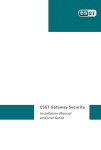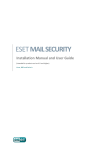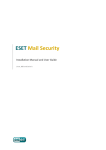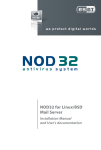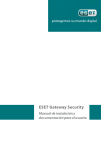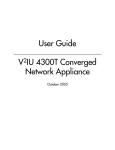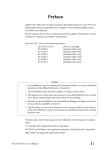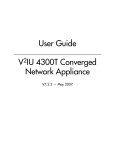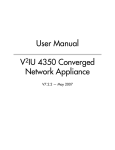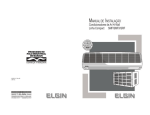Download ESET MAIL SECURITY 4 Installation manual
Transcript
we protect digital worlds
ESET Mail Security
Installation Manual
and User’s documentation
Table of contents
1. Introduction .......................................................................................... 3
2. Terminology and abbreviations..........................................................5
3. Installation.............................................................................................. 9
4. Product’s Roadmap.............................................................................11
5. Integration with E-mail Messaging System...................................15
5.1. Bi-directional e-mail messages scanning in MTA.............................17
5.2. Scanning of inbound e-mail messages................................................ 17
5.3. Scanning of outbound e-mail messages.............................................18
5.4. Scanning of e-mail messages being downloaded from POP3/
IMAP server.............................................................................................................18
5.5. Alternative methods of content filtering.............................................19
5.5.1. Scanning e-mail messages using AMaViS........................................19
6. Important ESET Mail Security mechanisms...................................21
6.1. Handle Object Policy................................................................................... 22
6.2. User Specific Configuration...................................................................... 23
6.3. Black-list and white-list..............................................................................24
6.4. Anti-Spam Control....................................................................................... 24
6.5. Samples Submission System.................................................................... 25
6.6. World WideWeb Interface..........................................................................25
6.7. Remote Administration..............................................................................26
7. ESET Mail Security system update...................................................27
7.1. ESETS update utility.................................................................................... 28
7.2. ESETS update process description......................................................... 28
8. Let us know...........................................................................................29
ESET Mail Security
Copyright © 2008 ESET, spol. s r.o.
ESET Mail Security was developed by
ESET, spol. s r.o. For more information
visit www.eset.com.
All rights reserved. No part of this
documentation may be reproduced,
stored in a retrieval system or
transmitted in any form or by any
means, electronic, mechanical,
photocopying, recording, scanning,
or otherwise without a permission in
writing from the author.ESET, spol. s
r.o. reserves the right to change any
of the described application software
without prior notice.This product
includes PHP software, freely available
from http://www.php.net/software/.
ESET Mail Security was developed in
co-operation with ProWeb Consulting.
For more information visit www.
pwc.sk.
A. ESETS setup process description.....................................................31
A.1. Setting ESETS for MTA Postfix..................................................................32
A.1.1. Inbound e-mail messages scanning..................................................32
A.1.2. Bi-directional e-mail messages scanning........................................32
A.2. Setting ESETS for MTA Sendmail.................... ........................................33
A.2.1. Inbound e-mail messages scanning..................................................33
A.2.2. Bi-directional e-mail messages scanning........................................34
A.3. Setting ESETS for MTA Qmail...................................................................34
A.3.1. Inbound e-mail messages scanning..................................................34
A.3.2. Bi-directional e-mail messages scanning........................................35
A.4. Setting ESETS for MTA Exim version 3..................................................35
A.4.1. Inbound e-mail messages scanning..................................................35
A.4.2. Bi-directional e-mail messages scanning........................................36
A.5. Setting ESETS for MTA Exim version 4..................................................36
A.5.1. Inbound e-mail messages scanning..................................................36
A.5.2. Bi-directional e-mail messages scanning........................................37
A.6. Setting ESETS for MTA ZMailer................................................................37
A.6.1. Inbound e-mail messages scanning..................................................37
A.6.2. Bi-directional e-mail messages scanning........................................37
A.7. Setting ESETS for outbound e-mail messages scanning...............37
A.8. Setting ESETS for scanning of POP3 communication.....................38
A.9. Setting ESETS for scanning of IMAP communication.....................39
B. PHP License.........................................................................................41
REV.20080513-007
2
ESET Mail Security
Chapter 1:
Introduction
Dear user, you have acquired ESET Mail Security - probably the best security system running
under the Linux/BSD/Solaris OS. As you will soon find out, the system using the state-of-the-art
ESET scanning engine, has unsurpassed scanning speed and detection rate, combined with a
very small footprint that makes it the ideal choice for any Linux/BSD/Solaris OS server.
In the rest of this chapter we review a key features of the system.
•The ESET anti-virus scanning engine algorithms provide the highest detection rate and the
fastest scanning times.
•The ESET Mail Security is developed to run on the single-processor as well as on the multiprocessor units.
•It includes unique advanced heuristics for Win32 worms and back-doors.
•Inbuilt archivers unpack archived objects without the need for any external programs.
•In order to increase speed and efficiency of the system, its architecture is based on the running
daemon (resident program) where all the scanning requests are sent to.
•All executive daemons (except esets_dac) run under non-privileged user account to enhance
security.
•The system supports selective configuration specific for user or client/server identification.
•Six logging levels can be configured to get information about system activity and infiltrations.
•The ESET Mail Security installation does not require external libraries or programs except for
LIBC.
•The system can be configured to notify any person in case of detected infiltration.
•Configuration, administration and license management can be provided using intuitive and
user friendly World Wide Web Interface.
•The system supports ESET Remote Administration for management in large computer
networks.
•The system contains anti-spam control mechanism.
•Information about infiltration can be configured to be written into an e-mail header, footer and
subject.
To run efficiently, ESET Mail Security requires just 16MB of hard-disk space and 32MB of RAM.
It works smoothly under the 2.2.x, 2.4.x and 2.6.x Linux OS kernel versions and also under 5.x, 6.x
FreeBSD OS kernel versions.
From lower-powered, small office servers to enterprise-class ISP servers with thousands of
users, the system delivers the performance and scalability you expect from a UNIX based solution
and the unequaled security of ESET products.
4
ESET Mail Security
Chapter 2:
Terminology
and abbreviations
In the following text we review terms and abbreviations used in this documentation. Note
that in this documentation (PDF format only) a boldface font is reserved for product components
names and in this chapter also for newly defined terms and abbreviations. Note also that terms
and abbreviations defined in this chapter are emphasized later in this documentation (PDF
format only).
ESETS
ESET Security is a common acronym for all security products developed by ESET, spol. s r.o. for
Linux OS, BSD OS and Solaris. It is also the name (or its part) of the software package containing
the products.
RSR
Abbreviation of ‘RedHat/Novell(SuSE) Ready’. Note that we support also so called RedHat
Ready and Novell(SuSE) Ready variation of the product. The difference from the “standard”
Linux version is that the RSR package meets criteria defined by FHS (File-system Hierarchy
Standard defined as a part of Linux Standard Base) document required by the RedHat Ready and
Novell(SuSE) Ready certificate. This means for instance that the RSR package is installed as an
add-on application, i.e. the primary installation directory is ‘/opt/eset/esets’.
ESETS daemon
Main ESETS system control and scanning daemon esets_daemon.
ESETS base directory
The directory where ESETS loadable modules containing for instance virus signatures database
are stored. Further in this documentation we use abbreviation @BASEDIR@ for the directory. The
directory location is as follows:
Linux: /var/lib/esets
Linux RSR: /var/opt/eset/esets/lib
FreeBSD: /var/lib/esets
NetBSD: /var/lib/esets
Solaris: /var/opt/esets/lib
ESETS configuration directory
A directory where all files related with the ESET File Security configuration are stored. Further
in this documentation we use abbreviation @ETCDIR@ for the directory. The directory location
is as follows:
Linux: /etc/esets
Linux RSR: /etc/opt/eset/esets
FreeBSD: /usr/local/etc/esets
NetBSD: /usr/pkg/etc/esets
Solaris: /etc/opt/esets
ESETS configuration file
Main ESET File Security configuration file. The absolute path of the file is as follows:
@ETCDIR@/esets.cfg
ESETS binary files directory
The directory where the relevant ESET File Security binary files are stored. Further in this
6
ESET Mail Security
documentation we use abbreviation @BINDIR@ for the directory. The directory location is as
follows:
Linux: /usr/bin
Linux RSR: /opt/eset/esets/bin
FreeBSD: /usr/local/bin
NetBSD: /usr/pkg/bin
Solaris: /opt/esets/bin
ESETS system binary files directory
The directory where the relevant ESET File Security system binary files are stored. Further in
this documentation we use abbreviation @SBINDIR@ for the directory. The directory location is
as follows:
Linux: /usr/sbin
Linux RSR: /opt/eset/esets/sbin
FreeBSD: /usr/local/sbin
NetBSD: /usr/pkg/sbin
Solaris: /opt/esets/sbin
ESETS object files directory
The directory where the relevant ESET File Security object files and libraries are stored. Further
in this documentation we use abbreviation @LIBDIR@ for the directory. The directory location is
as follows:
Linux: /usr/lib/esets
Linux RSR: /opt/eset/esets/lib
FreeBSD: /usr/local/lib/esets
NetBSD: /usr/pkg/lib/esets
Solaris: /opt/esets/lib
chapter 2 Terminology and abbreviations
7
Chapter 3:
Installation
This product is distributed as a binary file:
esets.i386.ext.bin
where ‘ext’ is a Linux/BSD/Solaris OS distribution dependent suffix, i.e. ‘deb’ for Debian, ‘rpm’
for RedHat and SuSE, ‘tgz’ for other Linux OS distributions, ‘fbs5.tgz’ for FreeBSD 5.xx, ‘fbs6.tgz‘ for
FreeBSD 6.xx, ‘nbs4.tgz‘ for NetBSD 4.xx and ‘sol10.pkg.gz‘ for Solaris 10.
Note that the Linux RSR binary file format is:
esets-rsr.i386.rpm.bin
In order to install or update the product, use statement:
sh ./esets.i386.ext.bin
resp. for Linux RSR variation of the product, use statement:
sh ./esets-rsr.i386.rpm.bin
As a result the product’s User License Acceptance Agreement is shown. Once you have
confirmed the Acceptance Agreement, the installation package is placed into the current
working directory and relevant information regarding the package’s installation, un-installation
or update is printed into terminal.
Once the package is installed and the main ESETS service is running, in Linux OS you can
check its operation by using command:
ps -C esets_daemon
In case of BSD OS you can use a command:
ps -ax | grep esets_daemon
In case of Solaris you can use a command:
ps -A | grep esets_daemon
You will see the following (or similar) message on return:
PID TTY
2226 ?
2229 ?
TIME CMD
00:00:00 esets_daemon
00:00:00 esets_daemon
where at least two ESETS daemon processes running in the background have to be present.
One of the processes is so-called process and threads manager of the system. The other serves
as ESETS scanning process.
10
ESET Mail Security
Chapter 4:
Product’s Roadmap
Once the product package has been successfully installed, it is time to become familiar with
its content.
Figure 4-1. Structure of ESET Mail Security.
WWW INTERFACE
AGENTS
CONFIGURATION
esets_cli
esets.cfg
esets_imap
license
esets_mda
UTILITIES
scripts
esets_pipe
esets_pop3
esets_smfi
esets_smtp
esets_lic
CORE
system
service
esets_quar
scanning
engine
esets_setup
esets_update
The structure of ESET Mail Security is shown in the figure 4-1. The system is composed of the
following components.
CORE
Core of ESET Mail Security consists of ESETS daemon esets_daemon. The daemon uses
ESETS API library libesets.so and ESETS loading modules em00X_xx.dat to provide base system
tasks: scanning, maintenance of the agent daemon processes, maintenance of the samples
submission system, logging, notification, etc.. Please refer to esets_daemon(8) manual page for
details.
AGENTS
The purpose of ESETS agent modules is to integrate ESETS with the Linux/BSD/Solaris Server
environment. Please note a special chapter in this document devoted to the topic.
UTILITIES
The utility modules are particular fraction of the system. They are developed to provide
simple and effective management of the system. They are responsible for relevant system tasks,
e.g. license management, quarantine management, system setup and update. Please note a
special chapter in this document devoted to the topic.
CONFIGURATION
The utility modules are particular fraction of the system. They are developed to provide
simple and effective management of the system. They are responsible for relevant system tasks,
e.g. license management, quarantine management, system setup and update. Please note a
special chapter in this document devoted to the topic.
After the product is successfully installed, all its configuration components are stored in
ESETS configuration directory. The directory consists of the following files.
12
ESET Mail Security
@ETCDIR@/esets.cfg
This is the most important configuration file as it maintains the major part of the product
functionality. After exploring the file you can see that it is built from various parameters
distributed within sections. Note the section names always enclosed in square brackets. In
the ESETS configuration file there is always one global and several so-called agent sections.
Parameters in global section are used to define configuration options of ESETS daemon as well as
default values of ESETS scanning engine configuration options. Parameters in agent sections are
used to define configuration options of so-called agents, i.e. modules used to intercept various
data flow types in the computer and/or its neighborhood and prepare this data for scanning.
Note that besides the number of parameters used for the system configuration, there is also a
number of rules determining organization of the file. To become familiar with this knowledge,
please refer to esets.cfg(5), esets_daemon(8) manual page and also to manual pages related to
relevant agents.
@ETCDIR@/certs
This directory is used to store the certificates used by ESETS WWW Interface for authentication
(see esets_wwwi(8) for details).
@ETCDIR@/license
This directory is used to store the product(s) license key(s) you have acquired from your
vendor. Note that the ESETS daemon will always check only this directory to evaluate license key
validity unless it is redefined by ESETS configuration file parameter ‘license_dir‘.
@ETCDIR@/scripts/license_warning_script
This script, if enabled by ESETS configuration file parameter ‘license_warn_enabled‘, is
executed since 30 days (once per day) before product license expiration. It is used to send e-mail
notification about the expiration status to system administrator.
@ETCDIR@/scripts/daemon_notification_script
This script, if enabled by ESETS configuration file parameter ‘exec_script‘, is executed in case
the infiltration has been detected by the anti-virus system. It is used to send e-mail notification
about the event to system administrator.
@ETCDIR@/anti-spam
This directory contains configuration file used to fine tune the anti-spam engine operation.
chapter 4 Product’s Roadmap
13
Chapter 5:
Integration with E-mail
Messaging System
This chapter describes integration of the ESET Mail Security with the variety of known e-mail
messaging systems. Knowledge of e-mail messaging system basic principles (figure 5-1) is of
paramount importance for understanding of ESETS operation.
Figure 5-1. Scheme of UNIX OS e-mail messaging system.
INTERNET
smtp
S1
smtp
MTA
pipe
file
S3
MAILBOX
E-Mail Server
smtp
User Agent
Client
S2
MDA
pop3/imap
User Agent
Client
S4
User Agent
Client
Local Network
MTA - Mail Transport Agent
A program (for instance sendmail, postfix, qmail, exim, etc.) providing e-mail messages
transfer among local and remote domains.
MDA - Mail Delivery Agent
A program (for instance maildrop, procmail, deliver, local.mail, etc.) providing delivery of
locally addressed e-mail messages into particular mailboxes.
MUA - Mail User Agent
A program (for instance MS Outlook, Mozilla Mail, Eudora, etc.) providing access and
management of e-mail messages, i.e. reading, composing, printing etc., stored in mailboxes.
MAILBOX
A file or a file structure on a disk serving as the storage space for e-mail messages. Note that
there are several formats of MAILBOX in Linux/BSD/Solaris OS: an old fashioned format where
e-mails for each user are stored sequentially in one user appropriate file located in directory ‘/
var/spool/mail’; MBOX (a bit newer but still an old format) with e-mails stored sequentially in one
file located within user home directory; MAILDIR with e-mails stored in a separate files within a
hierarchical directory structure.
The e-mail server receives data communication typically using SMTP - Simple Mail Transfer
Protocol communication. The received message is transferred by MTA either to another remote
e-mail messaging system or it is delivered using local MDA into particular MAILBOX (we assume
each local network user owns a MAILBOX located at the server disk). Note that it is responsibility
of the user’s local MUA to provide download and correct interpretation of the message at the
user’s computer. When retrieving data from MAILBOX the MUA uses typically POP3 - Post Office
16
ESET Mail Security
Protocol or IMAP - Internet Message Access Protocol to communicate with the MTA. To send data
to the Internet the SMTP protocol communication is used.
The ESETS operating principle is based on data communication interception and scanning
at the various phases of its transfer. The interception locations are marked in the figure 4-1 by
symbols S1, S2, S3 and S4.
S1
Bi-directional e-mail messages scanning, i.e. content filtering in MTA.
S2
Scanning of inbound e-mail messages, i.e. messages with the target address corresponding
to the destination located inside the local domain.
S3
Scanning of outbound e-mail messages, i.e. messages bound to some remote Internet
domain via its target address.
S4
Scanning of e-mail messages being downloaded from POP3/IMAP server.
The rest of this chapter reviews methods of integration of ESETS with variety of supported
messaging systems.
5.1. Bi-directional e-mail messages scanning in MTA
The advantage of bi-directional e-mail messages scanning mode is that it allows one to scan
e-mails inbound as well as outbound in the same implementation algorithm. On the other hand
the bi-directional (content filter) method is MTA dependent. The ESET comes with four content
filters built for most common MTA, i.e. MTA Sendmail, Postfix, Exim, QMail and ZMailer.
In order to configure ESET Mail Security for bi-directional e-mail messages scanning you have
to be sure that your MTA is properly configured and running. Then run this script:
esets_setup
Select MTA and contentfilter install options. Used ESETS module is also displayed.
Note that the installer backups all modified configuration files and can display all commands
it will execute after your approval. Use it for uninstall, too. The detailed steps for all possible
scenarios are described in the appendix A of this documentation.
5.2. Scanning of inbound e-mail messages
Scanning of the inbound e-mail messages is performed during the messages transfer
between MTA and MDA. The incoming e-mail is intercepted by esets_mda module, scanned by
ESETS daemon and delivered to MAILBOX using original MDA. As shown in the figure, the virus
chapter 5 Integration with E-mail messaging system
17
scanning can be enabled by proper configuration setting of MTA and esets_mda module. Note
that the ESET Mail Security supports most common MTA, i.e. MTA Sendmail, Postfix, Exim, QMail
and ZMailer. ESETS supports any MDA. In particular the following MDAs were tested: procmail,
maildrop, deliver and local.mail.
In order to configure ESET Mail Security for inbound e-mail messages scanning you have to be
sure that your MTA is properly configured using original MDA and running. Then run this script:
esets_setup
Select MDA and inbound install options. Used ESETS module is also displayed.
Note that the installer backups all modified configuration files and can display all commands
it will execute after your approval. Use it for uninstall, too. The detailed steps for all possible
scenarios are described in the appendix A of this documentation.
5.3. Scanning of outbound e-mail messages
Scanning of the outbound e-mail messages is performed during transfer of e-mail messages
between the local MUA and the MTA.
In order to configure ESET Mail Security for outbound e-mail messages scanning run this
script:
esets_setup
Select SMTP install option. It will setup esets_smtp module to listen on predefined port and
redirect applicable IP packets. Check added firewall rule and move it or change according your
needs.
Note that the installer backups all modified configuration files and can display all commands
it will execute after your approval. Use it for uninstall, too. The detailed steps for all possible
scenarios are described in the appendix A of this documentation.
5.4. Scanning of e-mail messages being downloaded from POP3/
IMAP server
In order to configure ESET Mail Security for scanning of e-mail messages downloaded from
POP3 (resp. IMAP) server run this script:
esets_setup
Select POP3 or IMAP install option. It will setup displayed ESETS module to listen on
predefined port and redirect applicable IP packets. Check added firewall rule and move it or
change according your needs.
Note that the installer backups all modified configuration files and can display all commands
it will execute after your approval. Use it for uninstall, too. The detailed steps for all possible
scenarios are described in the appendix A of this documentation.
18
ESET Mail Security
5.5. Alternative methods of content filtering
5.5.1. Scanning e-mail messages using AMaViS
AMaViS - A Mail Virus Scanner is a tool that interfaces your MTA and several anti-virus scanners.
It supports various MTAs and comes in three branches: amavis, amavisd and amavisd-new.
Amavis cooperates with ESET Mail Security by using esets_cli. Yet before we go into detailed
explanation of the Amavis configurations, we would like to discuss the impact of the method on
the ESET Mail Security functionality.
First, note that Amavis does not allow modification of the scanned e-mail messages. So no
infected e-mail attachments can be cleaned nor deleted by ESETS. Second consequence is that
no ESETS footnote with log and status dependent header fields will be written into the e-mail.
Next, amavis doesn’t provide mail sender/recipient, so no user specific configurations can be
used, too. Advanced mail handling (accept, defer, discard, reject) is also limited for esets_cli.
Lastly, it scans files and thus cannot use ESETS anti-spam engine.
Taking into account these drawbacks, this configuration is usable if only the above discussed
features of the product are not necessary for the user.
5.5.1.1. amavis
Configuration of Amavis is performed during the Amavis installation. After unpacking the
source amavis-0.x.y.tgz, create the file amavis/av/esets_cli with this contents:
#
# ESET Software ESETS Command Line Interface
#
if ($esets_cli) {
do_log(2,”Using $esets_cli”);
chop($output = `$esets_cli --subdir $TEMPDIR/parts`);
$errval = retcode($?);
do_log(2,$output);
if ($errval == 0) {
$scanner_errors = 0;
} elsif ($errval == 1 || $errval == 2 || $errval == 3) {
$scanner_errors = 0;
@virusname = ($output =~ /virus=”([^”]+)”/g);
do_virus();
} else {
}
do_log(0,”Virus scanner failure: $esets_cli (error code: $errval)”);
}
Note that the above script accepts the email only in case it is accepted in esets_cli’s Handle
Object Policy. In any other case, the mail is blocked. If it a virus was found, it’s name is extracted
from the output.
Next, if you are using the Linux RSR package, you have to update your PATH environment
variable with this command:
export PATH=”$PATH:/opt/eset/esets/bin”
For successful installation you may need to install additional software like arc, unarj, unrar,
19
zoo. You also have to make a symlink in /usr/bin from uncompress to gzip and create the user
amavis in group amavis with home dir /var/amavis. Now continue with the usual installation
process (./configure, make, make install) and follow the rules README.mta according your mail
server.
5.5.1.2. amavisd
Configuration of Amavisd is performed during the process of Amavisd installation. Unpack
the source amavisd-0.x.tgz and follow the rules for amavis described in previous section of this
guide. After ‘make install’ you may need to move ‘/usr/etc/amavisd.conf’ to ‘/etc’ and do a ‘make
install’ again.
5.5.1.3. amavisd-new
In order to install the product with Amavisd-new, unpack and install the source amavisdnew-2.x.y.tgz in your installation directory. Now to configure the product with newly installed
Amavisd-new, delete the clause for ‘ESET Software ESETS’ and replace the clause for ‘ESET
Software ESETS - Client/Server Version’ in file ‘amavisd.conf’ with the following one:
### http://www.eset.com/
[‘ESET Software ESETS Command Line Interface’,
‘@BINDIR@/esets_cli’, ‘--subdir {}’,
[0], [1, 2, 3], qr/virus=”([^”]+)”/ ],
You may need to install additional Perl modules Archive-Tar, Archive-Zip, BerkeleyDB,
Compress-Zlib, Convert-TNEF, Convert-UUlib, IO-stringy, MailTools, MIME-Base64, MIME-tools,
Net-Server and Unix-Syslog from www.cpan.org/modules. The procedure is by each as follows:
perl Makefile.PL; make; make install.
After configuration, please follow the recommendation for configuring Amavisd-new in
README.mta located in Amavisd-new directory according your mail server.
20
ESET Mail Security
Chapter 6:
Important ESET Mail
Security mechanisms
6.1. Handle Object Policy
The Handle Object Policy (see figure 5-1) is a mechanism that provides handling of the
scanned objects depending on their scanning status. The mechanism is based on so-called
action configuration options: ‘action_av‘, ‘action_av_infected‘, ‘action_av_notscanned‘, ‘action_
av_deleted‘, ‘action_as_spam‘, ‘action_as_notscanned‘. For detailed information on the options, please refer to the esets.cfg(5) manual page.
Figure 6-1. Scheme of Handle Object Policy mechanism.
action_av
accept
scan
defer, discard, reject
object not accepted
defer, discard, reject
object not accepted
action_av_infected
action_av_notscanned
action_av_deleted
accept
action_as
accept
scan
defer, discard, reject
object not accepted
defer, discard, reject
object not accepted
action_as_notscanned
accept
object accepted
Every object processed is at first handled with respect to the setting of the configuration
option ‘action_av‘. Once the option is set to ‘accept‘ (resp. ‘defer‘, ‘discard‘, ‘reject‘) the object is
accepted (resp. deferred, discarded, rejected). If the option is set to ‘scan‘ the object is scanned
(resp. also cleaned if requested by configuration option ‘av_clean_mode‘) for virus infiltrations
and set of action configuration options ‘action_av_infected‘, ‘action_av_notscanned‘ and
‘action_av_deleted‘ is taken into account to evaluate further handling of the object. If action
‘accept‘ has been taken as a result of the three above action options the object processed shall
be scanned for spam.
Note that object is scanned for spam only in case the configuration option ‘action_as‘ is set to
‘scan‘. In this case the action configuration options ‘action_as_spam‘ and ‘action_as_notscanned‘
is taken into account. If action ‘accept‘ (resp. ‘defer‘, ‘discard‘, ‘reject‘) has been taken as a result
of the two above action options the object is accepted for further delivery (resp. the object is
deferred, discarded or rejected).
NOTE: Please, note that some of the modules has been written to integrate ESETS into the environment which does not allow to
modify scanned objects and thus this functionality is disabled in the module. Particularly, this means that value configuration
option av_clean_mode is ignored by the module. To get detailed information on this topic, refer to appropriate modules
manual pages.
22
ESET Mail Security
6.2. User Specific Configuration
User Specific Configuration mechanism is implemented in the product in order to provide
administrator with enhanced configuration functionality. It allows to define ESETS anti-virus
scanner parameters selectively for client/server identification.
Please note that the detailed description of this functionality can be found in esets.cfg(5)
manual page and manual pages referenced there. Thus in this section we will only provide short
example of user specific configuration definition.
Let’s say we use esets_smtp module as a content filter for MTA Postfix. The module is subjected
to configuration section [smtp] in ESETS configuration file. The section is as follows:
[smtp]
agent_enabled = yes
listen_addr = ”localhost”
listen_port = 2526
server_addr = ”localhost”
server_port = 2525
action_av = ”scan”
In order to provide individual parameters setting one has to define ‘user_config’ parameter
with the path to the special configuration file where the individual setting will be stored. In the
next example we create reference to the special configuration file ‘esets_smtp_spec.cfg’ located
within the ESETS configuration directory.
[smtp]
agent_enabled = yes
listen_addr = ”localhost”
listen_port = 2526
server_addr = ”localhost”
server_port = 2525
action_av = ”scan”
user_config = ”esets_smtp_spec.cfg”
Once special configuration file referenced from within [smtp] section we have to create this
file in the ESETS configuration directory and provide it with an appropriate individual settings
[[email protected]]
action_av = ”reject”
Note that the section header name of the special section contains identification of the
recipient for which we have created the individual setting. The section body then contains
individual parameters specified for this identification. Thus with this special configuration all
e-mails will be processed, i.e. scanned for infiltrations, with exception of the e-mails sent to
[email protected] that will be rejected without scanning.
chapter 6 Important ESET Mail Security mechanisms
23
6.3. Black-list and white-list
In the next example we demonstrate the black-list and also white-list creation for the esets_
smtp configured as content filter for MTA Postfix. Note that we use configuration described in the
previous section for this purpose.
Thus in order to create black-list used by esets_smtp we have to create the following group
section within the special configuration file ‘esets_smtp_spec.cfg’ introduced in the previous
section.
[black-list]
action_av = ”reject”
The next step is to add some SMTP server into the ‘black-list’ group. For this purpose we have
to create special section
[|[email protected]]
parent_id = ”black-list”
where ‘[email protected]’ is an e-mail address of the sender added into the
‘black-list’. Note that with this setting all e-mail sent from this address will be rejected.
If we want to create the ‘white-list’ used by esets_smtp we have to create the following group
section within the special configuration file ‘esets_smtp_spec.cfg’ introduced in the previous
section.
[white-list]
action_av = ”accept”
action_as = ”accept”
Adding of sender’s e-mail address into the list is self-explanatory.
Please, note the character ‘|’ placed in front of the header name of the special section in case
of sender address and not placed there in case of recipient address. To get description of the
special header name syntax, please refer to the appropriate ESETS agent module manual page.
For an esets_smtp please refer to esets_smtp(1) manual page.
6.4. Anti-Spam Control
The goal of anti-spam system is to filter all spam e-mail messages, i.e. the e-mail messages
that the recipient users do not want, from data flow of the e-mail messages delivery process.
To get rid of spam, this product implements the anti-spam control mechanism. The anti-spam
functionality can be enabled using parameter ‘as_enabled’ (to get description of the parameter
see esets.cfg(5) manual page). Note that anti-spam scanning can be used only for e-mail objects,
thus this functionality is relevant only for esets_imap, esets_mda, esets_pipe, esets_pop3,
esets_smtp and esets_smfi modules.
Once anti-spam is enabled in any of the configuration sections the anti-spam scanning engine
is initialized during the main scanning daemon start-up. During this process an appropriate antispam supporting modules are loaded from within the anti-spam cache directory.
24
ESET Mail Security
It is also possible to configure anti-spam functionality using configuration file:
@ETCDIR@/anti-spam/spamcatcher.conf
Note the number of files within this directory, each corresponding to different recommended
settings of anti-spam engine. Note that the default configuration file corresponds to the
configuration file ‘spamcatcher.conf.faster’. In order to use any of the files just replace the default
anti-spam configuration file ‘spamcatcher.conf’ with the chosen one and reload ESETS daemon.
6.5. Samples Submission System
Samples submission system is an intelligent ThreatSense.NET technology that provides
catching of the infected objects found by advanced heuristics method and delivering these
objects to the samples submission system server. All virus samples catched by the sample
submission system will be processed by the team of ESET virus laboratory department and
consequently added into the ESET virus database, if necessary.
NOTE: ACCORDING TO OUR LICENSE AGREEMENT, BY ENABLING SAMPLE SUBMISSION SYSTEM YOU ARE AGREEING TO ALLOW
THE COMPUTER AND/OR PLATFORM ON WHICH THE ESETS_DAEMON IS INSTALLED TO COLLECT DATA (WHICH MAY INCLUDE
PERSONAL INFORMATION ABOUT YOU AND/OR THE USER OF THE COMPUTER) AND SAMPLES OF NEWLY DETECTED VIRUSES
OR OTHER THREATS AND SEND THEM TO OUR VIRUS LAB. THIS FEATURE IS TURNED OFF BY DEFAULT. WE WILL ONLY USE THIS
INFORMATION AND DATA TO STUDY THE THREAT AND WILL TAKE REASONABLE STEPS TO PRESERVE THE CONFIDENTIALITY OF
SUCH INFORMATION.
In order to turn on Samples Submission System, the samples submission system cache has
to be initialized. This can be achieved by enabling configuration option ‘samples_enabled’ in
[global] section of ESETS configuration file. In order to enable process of samples delivery to ESET
virus laboratory servers it is yet necessary to enable parameter ‘samples_send_enabled’ in the
same section.
User may decide to provide the ESET virus laboratory team with the additional optional
information using configuration options ‘samples_provider_mail’ and/or ‘samples_provider_
country’. This information will help us to get overview on the infiltration spreading throughout
the Internet.
In order to get detailed information on the Samples Submission System, refer to esets_
daemon(8) manual page.
6.6. World WideWeb Interface
WWW Interface allows user-friendly ESETS configuration, administration and license
management.
This module is a separate agent and must be explicitly enabled. For quickstart, set all of these
options in ESETS configuration file and restart ESETS daemon:
[wwwi]
agent_enabled = yes
listen_addr = address
listen_port = port
username = name
password = pass
chapter 6 Important ESET Mail Security mechanisms
25
(enter all four values as your own ones) and direct your browser to ’https://address:port’ (note
the https) and login with ’name/pass’. There are basic usage instructions on the help page. For
more technical details about esets_wwwi see the esets_wwwi(1) manual page.
6.7. Remote Administration
ESETS supports ESET Remote Administration for management in large computer networks.
For more information, please read the Remote Administration Manual.
ESETS Remote Administration Client is part of main ESETS daemon. For basic set up,
specify the address of your ERA Server in ‘racl_server_addr‘ parameter (and ‘racl_password‘ if
appropriate) in the global section of ESETS configuration file. All RA Client variables are listed in
the esets_daemon(8) manual page.
Unix ESETS RA Client has this functionality:
• logins to ERA Server and provides System Information, Configuration, Protection Status and
Features
• configuration can be viewed and changed using ESET Configuration Editor and applied with a
Configuration Task
• performs On-Demand Scan and Update Now Tasks as requested, with the Scan Logs sent back
to ERA Server
• sends notable scans performed by ESETS daemon to the Threat Log
• sends all non-debug messages to the Event Log
It doesn‘t support:
• Firewall Log
• remote installation
26
ESET Mail Security
Chapter 7:
ESET Mail Security system
update
7.1. ESETS update utility
In order to keep the ESET Mail Security effective, it is necessary to keep its virus signatures
database up to date. The esets_update utility has been developed for this purpose (see esets_
update(8) manual page for details). In order to launch update one has to define configuration
options ‘av_update_username‘ and ‘av_update_password‘ in [global] section of ESETS
configuration file. Note that in case you access the Internet via HTTP proxy additional configuration
options ‘proxy_addr‘, ‘proxy_port‘ and optionally ‘proxy_username‘ and ‘proxy_password‘ have
to be specified there as well. To trigger an update, enter command:
@SBINDIR@/esets_update
To provide the highest security for the user, the ESET team collects the virus definitions
continuously from all over the world. The new patterns can appear within the database in very
short intervals. It is therefore recommended, to trigger an update on a regular basis. Note that
ESETS daemon is able to provide the periodic update of the system once ‘av_update_period‘
configuration option specified in [global] section of ESETS configuration file and the daemon is
up and running.
7.2. ESETS update process description
The update process is composed of two stages. First, the so called pre-compiled modules are
downloaded from the origin ESET server. If configuration option ‘av_mirror_enabled‘ is enabled
in section [global] of ESETS configuration file, the mirror of these modules is created in directory
@BASEDIR@/mirror
Note that the mirror directory path can be redefined using configuration option ‘av_mirror_
dir‘ in section [update] of ESETS configuration file. The newly created mirror thus serves as fully
functional modules download server and can be used to create subordinate mirrors, however,
some more conditions have to be fulfilled yet. First, there must be a http server installed on the
computer where the modules are going to be downloaded from. Second, the modules to be
downloaded by other computers have to be placed at the directory path
/http-serv-base-path/eset_upd
where ‘http-serv-base-path‘ is a base http server directory path, as this is the first place where
update utility looks the modules for.
Second part of the update process is the compilation of modules loadable by the ESET Mail
Security scanner from those stored in the local mirror. Typically the following ESETS loading
modules are created: loader module (em000.dat), scanner module (em001.dat), virus signature
database module (em002.dat), archives support module (em003.dat), advanced heuristics
module (em004.dat), etc. in the directory:
@BASEDIR@
Note that it is exactly the directory where ESETS daemon loads modules from and thus can be
redefined by using configuration option ‘base_dir‘ in section [global] of ESETS configuration file.
28
ESET Mail Security
Chapter 8:
Let us know
Dear user, this guide should have given you a good knowledge about the ESET Mail Security
installation, configuration and maintenance. However, writing a documentation is a process that
is never finished. There will always be some parts that can be explained better or are not even
explained at all. Therefore, in case of bugs or inconsistencies found within this documentation,
please report a problem to our support center
http://www.eset.com/support
We are looking forward to help you solve any problem concerning the product.
30
ESET Mail Security
Appendix A. ESETS setup
process description
A.1. Setting ESETS for MTA Postfix
A.1.1. Inbound e-mail messages scanning
Warning: This installation is not compatible with SELinux. Either disable SELinux or follow
the next section.
The goal of this installation is to insert esets_mda before Postfix original MDA. Used MDA
(with arguments) is set in the Postfix parameter ‘mailbox_command’.
Note: If the value is empty, Postfix is delivering mail by himself. You have to install and configure a real
MDA (e.g. procmail) and use that first for ‘mailbox_command’ including arguments (e.g. /usr/
bin/procmail -d “$USER”). Reload Postfix and make sure it is delivering mail according your needs.
Now, you can continue with ESETS installation.
Take the full path to the current Postfix MDA and set the parameter ‘mda_path’ in [mda]
section of ESETS configuration file to this value, in our sample case:
mda_path = ”/usr/bin/procmail”
and restart ESETS daemon. Then replace the path to current Postfix MDA with esets_mda
path and add -- --recipient=”$RECIPIENT” --sender=”$SENDER” to the arguments, in our sample
case:
mailbox_command = @BINDIR@/esets_mda -d ”$USER”
-- --recipient=”$RECIPIENT” --sender=”$SENDER”
For reread of newly created configuration, reload Postfix.
A.1.2. Bi-directional e-mail messages scanning
The goal of this installation is to divert all mails from Postfix to esets_smtp and get them back.
In the [smtp] section of ESETS configuration file set these parameters:
agent_enabled
listen_addr =
listen_port =
server_addr =
server_port =
= yes
”localhost”
2526
”localhost”
2525
and restart ESETS daemon. It will start esets_smtp and make it scan all SMTP communication
accepted on ‘listen_addr:listen_port’ and forward it to ‘server_addr:server_port’. To divert all mail
to esets_smtp set in Postfix:
content_filter = smtp:[127.0.0.1]:2526
Note: In case the ‘content_filter’ parameter already has a value, don’t follow these instructions.
Instead, you have to insert esets_smtp (or other ESETS mail scanning module) before or after your
current ‘content_filter’.
32
ESET Mail Security
The last thing is to make Postfix accept mail on port 2525 and continue processing it. Add this
entry to Postfix master.cf file:
localhost:2525 inet n - n - - smtpd
-o content_filter=
-o myhostname=esets.yourdomain.com
-o local_recipient_maps=
-o relay_recipient_maps=
-o receive_override_options=no_unknown_recipient_checks,no_header_body_checks
-o smtpd_helo_restrictions=
-o smtpd_client_restrictions=
-o smtpd_sender_restrictions=
-o smtpd_recipient_restrictions=permit_mynetworks,reject
-o mynetworks=127.0.0.0/8
just replace yourdomain.com with your hostname after first dot. Make sure all but the first line
is indented. For reread of newly created configuration, reload Postfix.
Note: In case you have SELinux enabled, which prevents Postfix to listen on 2525 (e.g. Fedora Core >=
5), run this command: semanage -a -t smtp_port_t -p tcp 2525
A.2. Setting ESETS for MTA Sendmail
A.2.1. Inbound e-mail messages scanning
Warning: This installation is not compatible with SELinux. Either disable SELinux or follow
the next section.
The goal of this installation is to insert esets_mda before Sendmail’s original MDA.
Note: On FreeBSD, Sendmail may be communicating with MDA using LMTP. However, esets_mda does
not understand LMTP. So if you have FEATURE(local_lmtp) in `hostname`.mc, comment it out
now and recreate sendmail.cf.
The currently used MDA can be found in the file sendmail.cf in section Mlocal: parameters ‘P’
(executable) and ‘A’ (its name and arguments).
First set ‘mda_path’ in [mda] section of ESETS configuration file to the currently used MDA
executable (Sendmail’s ‘P’ parameter) and restart ESETS daemon.
Then add to file sendmail.mc (or `hostname`.mc on FreeBSD and Solaris) before all MAILER
definitions these lines:
define(`LOCAL_MAILER_PATH’, `@BINDIR@/esets_mda’)dnl
define(`LOCAL_MAILER_ARGS’,
`esets_mda original_arguments -- --sender $f --recipient $u@$j’)dnl
where original_arguments is Sendmail’s ‘A’ parameter without the name (first word).
In the last, recreate sendmail.cf and restart Sendmail.
Appendix A. ESETS setup process description
33
A.2.2. Bi-directional e-mail messages scanning
The goal of this installation is to scan all mails in Sendmail with esets_smfi filter. In the [smfi]
section of ESETS configuration file set these parameters:
agent_enabled = yes
smfi_sock_path = ”/var/run/esets_smfi.sock”
and restart ESETS daemon. Then add to file sendmail.mc (or `hostname`.mc on FreeBSD)
before all MAILER definitions this line:
INPUT_MAIL_FILTER(`esets_smfi’,
`S=local:/var/run/esets_smfi.sock, F=T, T=S:2m;R:2m;E:5m’)dnl
With these settings, Sendmail will communicate with esets_smfi via unix socket /var/run/
esets_smfi.sock. Flag F=T will result in a temporary fail connection, if the filter is unavailable.
Timeouts S:2m defines 2 minutes timeout for sending information from MTA to filter, R:2m
defines 2 minutes timeout for reading reply from the filter and E:5m means overall 5 minutes
timeout between sending end-of-message to filter and waiting for the final acknowledgment.
Note that in case the timeouts for the esets_smfi filter are set too small, Sendmail can
temporarily defer the message to the queue and attempt to pass it through later. This may lead
to continuous deferral of the same messages. In order to avoid the problem, the timeouts have
to be set properly. One can also experiment with the Sendmail’s ‘confMAX_MESSAGE_SIZE’
parameter, which is the maximum accepted message size in bytes. Taking into account this value
and the maximum time for processing of this amount of data by MTA (this can be measured), one
can evaluate the appropriate timeouts for esets_smfi filter.
In the last, recreate sendmail.cf and restart Sendmail.
A.3. Setting ESETS for MTA Qmail
A.3.1. Inbound e-mail messages scanning
The goal of this installation is to insert esets_mda before Qmail’s local delivery agent. Let’s
assume, Qmail is installed in the /var/qmail directory. In the [mda] section of ESETS configuration
file set this parameter:
mda_path = ”/var/qmail/bin/qmail-esets_mda”
and restart ESETS daemon. Create the file /var/qmail/bin/qmail-esets_mda with this content
and run chmod a+x on it:
#!/bin/sh
exec qmail-local -- ”$USER” ”$HOME” ”$LOCAL” ”” ”$EXT” \
”$HOST” ”$SENDER” ”$1”
which will make esets_mda call Qmail’s local delivery agent. Now create the file /var/qmail/
bin/qmail-start.esets with this content and also run chmod a+x on it:
#!/bin/sh
A=”$1”; shift
34
ESET Mail Security
exec qmail-start.orig ”|@BINDIR@/esets_mda ‘$A’”’ \
-- --sender=”$SENDER” --recipient=”$RECIPIENT”’ “$@”
which will start Qmail using esets_mda for local deliveries. However, the original delivery
specification is passed to qmail-local through esets_mda. Note that in this configuration esets_
mda will use Qmail’s recognized exit codes (see qmail-command(8)). Lastly, replace qmail-start
using commands:
mv /var/qmail/bin/qmail-start /var/qmail/bin/qmail-start.orig
ln -s qmail-start.esets /var/qmail/bin/qmail-start
and restart Qmail.
A.3.2. Bi-directional e-mail messages scanning
The goal of this installation is to insert esets_mda before qmail-queue, which queues all
mails before delivery. Let’s assume Qmail is installed in the /var/qmail directory. In the [mda]
section of ESETS configuration file set this parameter:
mda_path = ”/var/qmail/bin/qmail-queue.esets”
and restart ESETS daemon. Lastly, replace qmail-queue using commands:
mv /var/qmail/bin/qmail-queue /var/qmail/bin/qmail-queue.esets
ln -s @BINDIR@/esets_mda /var/qmail/bin/qmail-queue
No Qmail restarting is necessary. All messages enqueued from now will be scanned by
ESETS. Note that in this configuration esets_mda will use qmail-queue’s exit codes (see qmailqueue(8)).
A.4. Setting ESETS for MTA Exim version 3
A.4.1. Inbound e-mail messages scanning
The goal of this installation is to create an Exim transport from esets_mda for local users. In
the [mda] section of ESETS configuration file set this parameter:
mda_path = ”/usr/sbin/exim”
where /usr/sbin/exim is the full path to Exim binary. Then restart ESETS daemon. Next, add this
transport (at whatever place) to the list of Exim transports:
esets_transport:
driver = pipe
command = @BINDIR@/esets_mda -oi -oMr esets-scanned $local_part@$domain \
-- --sender=$sender_address --recipient=$local_part@$domain
user = mail
where mail is one of Exim’s ‘trusted_users’. Then add this director as first to the list of Exim
directors:
Appendix A. ESETS setup process description
35
esets_director:
driver = smartuser
condition = ”${if eq {$received_protocol}{esets-scanned} {0}{1}}”
transport = esets_transport
verify = false
which will send all not-yet-scanned mails for local users to esets_mda, which will inject them
back to Exim for further processing. For reread of newly created configuration, restart Exim.
A.4.2. Bi-directional e-mail messages scanning
The goal of this installation is to create an Exim transport from esets_mda for all mails.
Perform all steps from the previous section, but also add this router as first to the list of Exim
routers:
esets_router:
driver = domainlist
route_list = ”* localhost byname”
condition = ”${if eq {$received_protocol}{esets-scanned} {0}{1}}”
transport = esets_transport
verify = false
A.5. Setting ESETS for MTA Exim version 4
A.5.1. Inbound e-mail messages scanning
The goal of this installation is to create an Exim transport from esets_mda for local users. In
the [mda] section of ESETS configuration file set this parameter:
mda_path = ”/usr/sbin/exim”
where /usr/sbin/exim is the full path to Exim binary. Then restart ESETS daemon. Add this
router as first to the list of Exim routers:
esets_router:
driver = accept
domains = +local_domains
condition = ”${if eq {$received_protocol}{esets-scanned} {0}{1}}”
transport = esets_transport
verify = false
and this transport (at whatever place) to the list of Exim transports:
esets_transport:
driver = pipe
command = @BINDIR@/esets_mda -oi -oMr esets-scanned $local_part@$domain \
-- --sender=$sender_address --recipient=$local_part@$domain
which will send all not-yet-scanned mails for local users to esets_mda, which will inject them
back to Exim for further processing. For reread of newly created configuration, restart Exim.
36
ESET Mail Security
A.5.2. Bi-directional e-mail messages scanning
The goal of this installation is to create an Exim transport from esets_mda for all mails.
Perform all steps from the previous section, but omit this line in esets_router:
domains = +local_domains
A.6. Setting ESETS for MTA ZMailer
A.6.1. Inbound e-mail messages scanning
The goal of this installation is to use esets_mda as ZMailer‘s local delivery agent. However,
you need to have a real MDA installed, e.g. procmail. In the [mda] section of ESETS configuration
file set this parameter:
mda_path = ”/path/to/procmail”
and restart ESETS daemon. Procmail doesn‘t support full email address as recipient, so
comment out this line in ZMailer‘s router.cf prepending a ‘#‘:
localdoesdomain=1
Next, in the ‘local/*‘ clause of scheduler.conf replace your current delivery command with:
command=”sm -c $channel esets”
and append this line to sm.conf (replace your.hostname.com with your FQDN):
esets sSPfn @BINDIR@/esets_mda esets_mda -a $h -d $u
-- --sender $g --recipient [email protected]
Finally restart ZMailer.
A.6.2. Inbound e-mail messages scanning
The goal of this installation is to use esets_zmfi as ZMailer‘s smtp contentfilter. First start
ESETS daemon. Then add this line to smtpserver.conf:
PARAM contentfilter @BINDIR@/esets_zmfi
and restart ZMailer.
Please note, that this will scan only mails incoming through the smtpserver. And make sure
that your smtp-policy is filtering all mails you want it to.
A.7. Setting ESETS for outbound e-mail messages scanning
The outbound e-mail messages scanning is performed using esets_smtp daemon. In the
[smtp] section of ESETS configuration file set these parameters:
Appendix A. ESETS setup process description
37
agent_enabled = yes
listen_addr = ”192.168.1.0”
listen_port = 2525
where ‘listen_addr’ is the address of local network interface named if0. Then restart ESETS
daemon. The next step is to redirect all SMTP requests to esets_smtp. In case of IP-filtering
provided by ipchains administration tool an appropriate rule is:
ipchains -A INPUT -p tcp -i if0 --dport 25 -j REDIRECT 2525
If IP-filtering mechanism is provided by iptables administration tool, the rule is:
iptables -t nat -A PREROUTING -p tcp -i if0 \
--dport 25 -j REDIRECT --to-ports 2525
On FreeBSD, the rule is as follows:
ipfw add fwd 192.168.1.10,2525 tcp from any to any 25 via if0 in
On NetBSD and Solaris:
echo ’rdr if0 0.0.0.0/0 port 25 -> 192.168.1.10 \
port 2525 tcp’ | ipnat -f Warning: Your MTA may accept all connections without extensive checking from esets_smtp
because they are local. By using your own firewall rules, make sure you do not create an open
relay, i.e. allow someone from the outside to connect to esets_smtp and thus use him as relay
SMTP server.
A.8. Setting ESETS for scanning of POP3 communication
The POP3 communication scanning is performed using esets_pop3 daemon. In the [pop3]
section of ESETS configuration file set these parameters:
agent_enabled = yes
listen_addr = ”192.168.1.10”
listen_port = 8110
where ‘listen_addr’ is the address of local network interface named if0 Then restart ESETS
daemon. The next step is to redirect all POP3 requests to esets_pop3. In case of IP-filtering
provided by ipchains administration tool an appropriate rule is:
ipchains -A INPUT -p tcp -i if0 --dport 110 -j REDIRECT 8110
If IP-filtering mechanism is provided by iptables administration tool, the rule is:
iptables -t nat -A PREROUTING -p tcp -i if0 \
--dport 110 -j REDIRECT --to-ports 8110
On FreeBSD, the rule is as follows:
38
ESET Mail Security
ipfw add fwd 192.168.1.10,8110 tcp from any to any 110 via if0 in
On NetBSD and Solaris:
echo ’rdr if0 0.0.0.0/0 port 110 -> 192.168.1.10 \
port 8110 tcp’ | ipnat -f -
A.9. Setting ESETS for scanning of IMAP communication
The IMAP communication scanning is performed using esets_imap daemon. In the [imap]
section of ESETS configuration file set these parameters:
agent_enabled = yes
listen_addr = ”192.168.1.10”
listen_port = 8143
where ‘listen_addr’ is the address of local network interface named if0 Then restart ESETS
daemon. The next step is to redirect all IMAP requests to esets_imap. In case of IP-filtering
provided by ipchains administration tool an appropriate rule is:
ipchains -A INPUT -p tcp -i if0 --dport 143 -j REDIRECT 8143
If IP-filtering mechanism is provided by iptables administration tool, the rule is:
iptables -t nat -A PREROUTING -p tcp -i if0 \
--dport 143 -j REDIRECT --to-ports 8143
On FreeBSD, the rule is as follows:
ipfw add fwd 192.168.1.10,8143 tcp from any to any 143 via if0 in
On NetBSD and Solaris:
echo ’rdr if0 0.0.0.0/0 port 143 -> 192.168.1.10 \
port 8143 tcp’ | ipnat -f -
39
Appendix B. PHP License
The PHP License, version 3.01 Copyright (c) 1999 - 2006 The PHP Group. All rights reserved.
Redistribution and use in source and binary forms, with or without modification, is permitted
provided that the following conditions are met:
1. Redistributions of source code must retain the above copyright notice, this list of
conditions and the following disclaimer.
2. Redistributions in binary form must reproduce the above copyright notice, this list of
conditions and the following disclaimer in the documentation and/or other materials
provided with the distribution.
3. The name “PHP” must not be used to endorse or promote products derived from this
software without prior written permission. For written permission, please contact group@
php.net.
4. Products derived from this software may not be called “PHP”, nor may “PHP” appear in
their name, without prior written permission from [email protected]. You may indicate that
your software works in conjunction with PHP by saying “Foo for PHP” instead of calling it
“PHP Foo” or “phpfoo”
5. The PHP Group may publish revised and/or new versions of the license from time to time.
Each version will be given a distinguishing version number. Once covered code has been
published under a particular version of the license, you may always continue to use it under
the terms of that version. You may also choose to use such covered code under the terms of
any subsequent version of the license published by the PHP Group. No one other than the
PHP Group has the right to modify the terms applicable to covered code created under this
License.
6. Redistributions of any form whatsoever must retain the following acknowledgment: “This
product includes PHP software, freely available from <http://www.php.net/software/>”.
THIS SOFTWARE IS PROVIDED BY THE PHP DEVELOPMENT TEAM ``AS IS’’ AND ANY EXPRESSED
OR IMPLIED WARRANTIES, INCLUDING, BUT NOT LIMITED TO, THE IMPLIED WARRANTIES OF
MERCHANTABILITY AND FITNESS FOR A PARTICULAR PURPOSE ARE DISCLAIMED. IN NO EVENT
SHALL THE PHP DEVELOPMENT TEAM OR ITS CONTRIBUTORS BE LIABLE FOR ANY DIRECT,
INDIRECT, INCIDENTAL, SPECIAL, EXEMPLARY, OR CONSEQUENTIAL DAMAGES (INCLUDING, BUT
NOT LIMITED TO, PROCUREMENT OF SUBSTITUTE GOODS OR SERVICES; LOSS OF USE, DATA, OR
PROFITS; OR BUSINESS INTERRUPTION) HOWEVER CAUSED AND ON ANY THEORY OF LIABILITY,
WHETHER IN CONTRACT, STRICT LIABILITY, OR TORT (INCLUDING NEGLIGENCE OR OTHERWISE)
ARISING IN ANY WAY OUT OF THE USE OF THIS SOFTWARE, EVEN IF ADVISED OF THE POSSIBILITY
OF SUCH DAMAGE.
42
ESET Mail Security










































